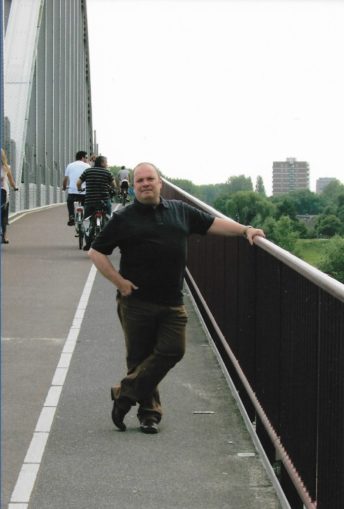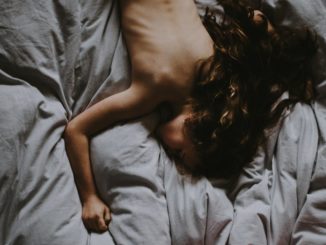
In the final part of this series before I move onto etchings, I’m doing a piece on painting with acrylic paint onto a stretched frame canvas. The principles apply just as well for oil painting, which smells nice, allows you to have a lovely, subtle finish but takes ages to dry and I’m impatient. I prefer oil paints, but they are not cheap and I think acrylic paints are a good medium before trying oils. Don’t let me put you off. If you want to dive in with oil paints then go for it. There are media which will accelerate the drying time and there is nothing like the satisfaction you get finishing an oil painting. But I think the same basic principles apply to both types of media.
You will need plenty of brushes and normal decorators’ brushes are fine for laying down large areas of colour. You should have about ten colours: lots of white, a couple of ochres and burnt sienna, dark and light blue, brilliant yellow and a couple of greens. Have a Payne’s grey for really dark areas, but use it sparingly. Unless you are Caravaggio or Manet. An absolute essential is an easel to support the canvas, while you dab away in your spotted neckerchief and Breton smock.

I’m going to attempt the cover artwork for War Crimes, and a particular moment in the story when the Puma helicopter is shot down over the Shat Al Arab Waterway.
The interior of the Puma was a shambles, the aircraft lying partially on its port side. Half of the interior was full of stinking, muddy water. Gilmore groaned and pulled himself into the cockpit, having to push the pilot’s body out of the way.
The exact moment is when Gilmore takes one last, despairing look at his dying co-pilot, before heading off for his appointment with the JAM and later Messrs Edge, Morrison, Jarvis and Cooper. The downing of the Puma is central to the story and draws together five of the main characters. As anyone who knows that part of the world can tell you, I’ve taken some liberties with the story as in time of day and position of the sun, not to mention the final attitude of the Puma. The picture will be from the perspective of the Firuziyah bank, looking west across the Arvand Rood to Sinbad Island and the bridge into northern Basra.
It’s difficult to see, but the sketch shows the helicopter on its side in the water, just off the bank. There’s a reed bed on the left and the upper rotor head, gearbox and engine have detached backwards from the cab, because the spinning Puma hit the muddy water tail first. You can still see on the canvas the outline of what was going to be the Boston Stump. I wanted the church to sit under a dark, glowering sky, but as I’d used too much Payne’s grey, it looked more like an apocalyptic nuclear winter on the Fens. I decided to try and recycle the canvas.

Firstly I decided on what kind of sky I wanted. I would like to have the effect of the sun on the river under a glowering sky of a different hue. The kind of sky where the wind blows dust in from the desert and turns the sky into a peculiar yellowish hue, layering the dust under the blue sky of higher altitudes. Not a regular sandstorm, just the annoying particles in the air full of sand and dried excrement that cause conjunctivitis.
Laying down the base for the Sky
Yellow can be a difficult colour to cover, so I decided to put down a wash as an initial marker. The paint was watered down, blue at the top and yellow for the lower two-thirds of the sky. Top is Prussian blue with lemon yellow below. At this point it all looks worryingly crap. I’ve been here before, which is why the Boston Stump has been overpainted.

Don’t give up. I soon realised that the Boston Stump could have been salvaged as it continues to peek through the yellow wash. Then it occurred to me that perhaps I should have turned the canvas upside-down as the darker foreground would have covered it much better. Damn!
Building up the sky
Once the wash is dry, preferably overnight, the build-up of the sky can go ahead. This took two blues, Prussian and sky, and about three different yellows, an orange and a red ochre. There’s no quick way, just continue to lay down the colours, blending them while the paint is still wet. You can also use a paint inhibitor, a clear jell that’s mixed in with the paints to improve viscosity and lengthen the drying time. It took about three separate washes, allowing the paint to dry thoroughly between each one, before I arrived at this stage. The sky is more or less there and I’ve added some background such as the bridge and columns of smoke. The smoke is heavily diluted Payne’s grey with burnt sienna.
The sun is hazy behind the dusty sky. Use whatever brush strokes work for you. I prefer to dab rather than wipe across the canvas and the haze around the sun has been laid down with circular strokes.

Building up the foreground and mid-ground
The next step is to paint the reed bed, water and the sun reflecting off the river. The bank and reeds are indistinct because I wanted to try and show steam from the heat of the engines. The foreground is in shadow where the helicopter will lie in the water. The colours are basically the same as the sky, with the addition of darker colours for the ripples, even Payne’s grey, but this time I was going to be careful.
Once I’m reasonably happy with the water and the muddy bank with the reeds, I make the first attempt to do the top of the Puma, including the engine intakes and rotor head. Puma’s in Iraq were still green as repainting is costly, but they ended up as a dusty, scarified light green.
Between the engines and the cab is a jumble of equipment and components that are normally hidden. Being hit by an RPG doesn’t tend do do components much good so it’s meant to look like a wreck. The rotor blade on the right has shredded because they’re made of composites and mineral fibres. Very dangerous to the lungs as they can spall into small particles. The cockpit perspex has gone completely on the port side, and the rest is meant to look opaque from being shattered by the impact of the crash. There’s still a small fire in the starboard engine.

Completing the painting
The final part is to paint in the loadmaster. He’s just heaved himself out of the cockpit and takes a last look the co-pilot before sliding down the side of the cab into the river. His growbag is desert yellow, although a lot of crewmen wore their desert camouflage kit because they’re in and out of the cabs all the time. Below is the finished painting that took about a week to complete, allowing the build-up of washes to dry.
It really is essential that you have a room, outhouse or shed where all the kit can be left, unmolested by children or cats. To really bring the painting to life, it can be coated in a matt or satin varnish. The painting below is as yet unvarnished.

Although it isn’t in the story, I added the flying Puma to break up the sky, and on the cover could be part of the spine, in the extremely unlikely event it is ever published as a book. Still, we live in hope. I haven’t got a clue what to put on the back cover yet. Suggestions please on a postcard.
By the way, I wasn’t serious about etchings. I have no intention of messing around with Barium Sulphate, Sulfuric Acid, Sodium Bifluoride and Ammonium Bifluoride.
I have used that awful, hackneyed line once. Amazingly it worked.
The Goodnight Vienna Audio file
© Chris Downes/Blown Periphery 2018 2023

Christophe Downes 28th July 1957 – 30th March 2023



